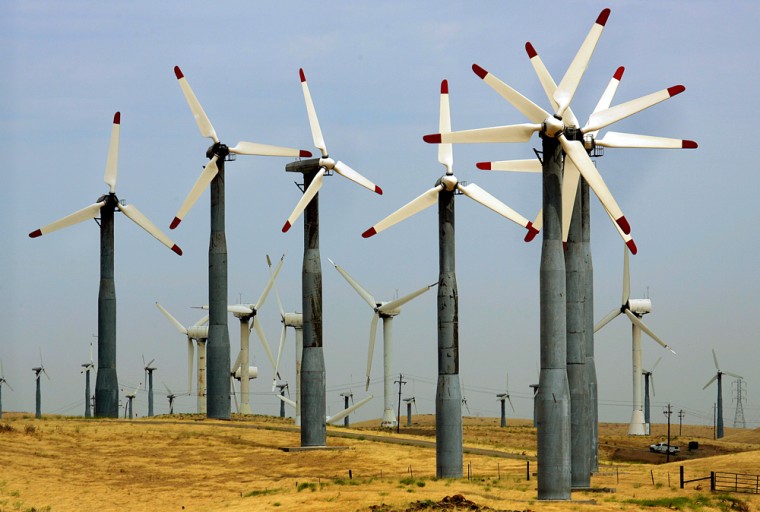A team of eight workers scrambled to assemble the 185th windmill in the largest wind farm in the northeastern United States. They had 10 more to build and wanted to wrap up the job by Labor Day.
Scott Alexander, operations manager for the Maple Ridge Wind Farm, stood below, watching a towering crane holding a 20-ton, three-bladed propeller 260 feet above him. He didn't appear worried about the gravity-defying operation.
Alexander was bothered by another electricity-generating wind turbine that couldn't be built yet because a section of its base had been damaged in transit.
"Trying to get a replacement piece has become a big issue," Alexander said. "We're putting these up one a day, but we're going to be delayed by that piece."
Maple Ridge, 300 miles northwest of New York City, between Lake Ontario and the Adirondack Mountains, isn't alone in its hunt for parts.
Wind farms are going up across the country at a rapid pace. This month, the United States passed the 10,000-megawatt mark in installed wind turbine capacity, according to the American Wind Energy Association, which projects that by the end of next year, that number will reach 15,000 megawatts -- enough to power 3.8 million typical American homes.
That's left major wind turbine manufacturers, including Vestas Wind Systems AS, the Danish company that made the turbines being installed at Maple Ridge, General Electric Co. and Siemens AG, scrambling to meet demand.
"This is a global industry and there is a global shortage of wind turbines," said Randall Swisher, executive director of the Washington-based Wind Energy trade group.
Keeping up with demand
To help meet demand, German conglomerate Siemens this month said it plans to open a factory in Fort Madison, Iowa, to make wind-turbine blades, its first such U.S. facility.
In this country, Siemens in 2006 has booked orders for turbines capable of producing 600 megawatts of electricity, and expects to double its U.S. volume over the next three years.
GE, the world's second-largest company by market capitalization, has a similarly aggressive growth forecast, and says it has booked as many orders as it can fill for 2006 and 2007, and is already taking orders for 2008 deliveries.
"We're seeing tremendous demand growth, in particular in the United States," said Victor Abate, vice president of renewable energy at GE.
Abate said GE is on track to record $3.4 billion in wind turbine sales this year, shipping 2,000 turbines. That's up from $2.3 billion in sales last year. Abate said he expects 30 percent revenue growth at the wind unit in 2007.
Renewable yes, reliable maybe
To advocates of renewable energy, wind farms are a golden goose. They burn no fuel, and thus release no carbon dioxide when they operate. Their main byproducts are the hissing noise the blades make cutting through the air, unusual shadow patterns on the ground and occasional TV interference.
Not everyone agrees with that rosy assessment. Opponents of wind farms in the United States object to the noise and disruption of view, and also question their productivity. One major farm proposed off Cape Cod in Massachusetts has run into just such criticism.
But with rising prices for oil and natural gas -- a key fuel for many U.S. electricity plants -- advocates argue their price stability makes them a good choice.
"What's the probability that natural gas will change in price?" Abate asked. "Wind won't change in price."
But wind turbines have one obvious weakness -- they need wind, preferably blowing at about 10 miles to 25 miles per hour, to generate electricity. On the still day Alexander's crew hoisted the giant propeller, other nearby turbines were turning lazily but not generating any power.
Wind farms currently generate about 0.5 percent of the United States' electricity supply, the AWEA estimates. It's aiming to raise that to 20 percent. But industry experts called that an unrealistic target.
"It can't be counted on for reliable supply," said Paul Flemming, director of power and gas at Energy Security Analysis Inc., a research firm. "When ... it's hot and humid and no breeze, that's just when we need the power the most. And those windmills will just be sitting there."
Analysts and wind industry executives said that a more realistic goal might be to have wind generate 6 percent to 10 percent of the nation's energy.
Peter Bates, an equity analyst with mutual fund company T. Rowe Price Associates, said wind holds great potential for GE.
"It is a very viable alternative energy solution and GE has the technology and the domain knowledge to make it happen," Bates said.
Goldman Sachs Group Inc. and Scottish Power own Maple Ridge through investment vehicles.
The largest U.S. wind farm, on the Oregon-Washington border, is owned by a unit of FPL Group Inc.
